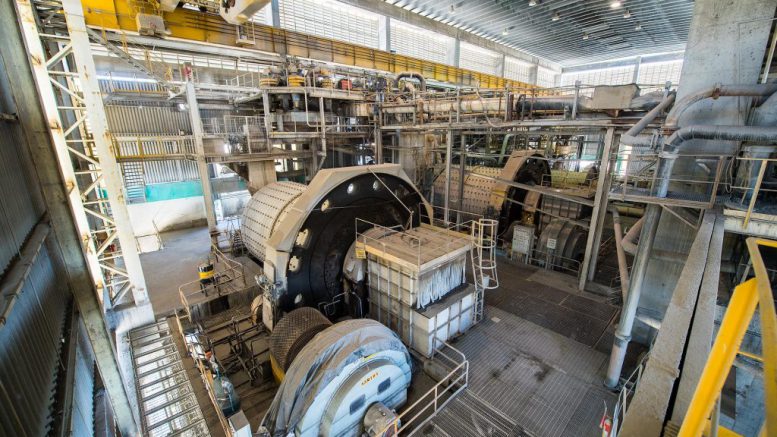Brazil-focused Ero Copper (TSX: ERO; NYSE: ERO) is reporting new drill results for nickel targets at Caraíba as it advances the Tucumã project to double the company’s copper output by 2025.
The Umburana nickel system, announced in September, lies about 20 km from Ero’s main operation Caraíba in the Curaçá Valley of the eastern state of Bahia.
In Umburana’s VB zone, diamond drill hole VB-41 cut 11.2 metres grading 1.86% nickel, 0.26% copper and 0.05% cobalt (2.08% nickel equivalent or NiEq), Ero said in a news release on Thursday. The interval included 5 metres at 3.71% nickel, 0.13% copper and 0.09% cobalt (4% NiEq).
In the Lazaro zone at Umburana, hole LZ-25 returned 46.1 metres at 0.20% nickel, 0.04% copper and 0.03% cobalt (0.28% NiEq), including 2.6 metres at 0.75% nickel, 0.18% copper and 0.06% cobalt (0.96% NiEq).
BMO Capital Markets expects more substantial results near year-end after more drilling, mining analyst Jackie Przybylowski wrote in a note on Friday.
“Ero expects to delineate a larger number of open pittable and underground mineable nickel deposits in time,” Przybylowski said. “We expect a bigger release in ‘the great reveal’ later this year circa November.”
Vancouver-based Ero is poised to benefit from the battery metals surge in demand as it also develops the US$305 million Tucumã copper project in the northeastern state of Pará. Construction was about a third completed by the end of March. Foundations for the primary crusher and ball mill are to be completed within days.
See Ero Copper’s assets here in 3-D by Vrify.
Przybylowski said Ero’s focus on copper and nickel in Brazil provides a unique competitive advantage.
“The company leverages its strong intellectual capital in Brazil including its experienced exploration team and its connections in the country,” she said. “Ero is in the flow on information and opportunities.”
Drilling at Umburana has determined a strike length of about five km, Ero said. Mineralization forms outcrops at the surface and remains open to depth to the north and between the VB and Lazaro zones.
Metallurgical tests suggest most of the system’s nickel is within sulphides instead of silicate minerals that would make it unrecoverable. Recoveries so far are between 77% and 91%. More tests are being done to determine whether saleable concentrate grades are achievable, and if so, overall nickel recoveries, the company said.
“The Umburana system demonstrates the Curaçá Valley’s potential to be a globally significant magmatic sulphide district for both copper and nickel,” Ero CEO David Strang said in the release. “Our exploration team has identified several new and distinct nickel targets within the Curaçá Valley with similar geological signatures to the Umburana system, which we are currently drilling or plan on drilling later this year.”

Ero Copper CEO David Strang. Credit: Ero Copper
Shares in Ero Copper gained 3% to $24 apiece in Friday afternoon trading in Toronto, within a 52-week range of $10.54 to $28.05, valuing the company at $2.25 billion.
In April, Ero hiked its copper output forecast to 125% of last year’s amount by 2025. It is aiming for a range of 100,000 to 110,000 tonnes, replacing a January forecast of 92,000 to 102,000 tonnes.
The price of copper, at US$3.74 per lb. on Friday, has gained about US10¢ this month, but has remained below the important US$4 per lb. mark it last hit in April. Factory output has slowed in Europe and the United States because rising interest rates and inflation hurt demand. China grew faster than expected in the first quarter but has suffered a building sector downturn.
In January, Ero hedged 33,000 tonnes of its copper production, about three quarters of forecast 2023 output, with a base price of US$3.50 per lb., protecting a “meaningful portion of the company’s revenue,” it said. Copper hit a low this year of US$3.59 per lb. on May 25.
Caraíba, 385 km northwest of the state capital of Salvador, includes the Pilar and Vermelhos underground copper mines and the Surubim open pit mine. Ero is advancing plans to maintain annual ore production at 3 million tonnes by building a new shaft and recovering higher grades at Pilar and expanding the mill to 4.2 million tonnes capacity from 3 million tonnes. Caraíba is expected to produce 44,000 to 47,000 tonnes of copper in concentrate this year.
The Xavantina gold operation in Mato Grasso state had its best output of 12,443 oz. in the first quarter as ore grades doubled from a year earlier to 11.9 grams per tonne. However, higher costs are expected with falling grades this year. The Matinha vein is on track to begin production in the second half, ahead of next year’s originally planned start, the company said in April.
Company-wide, gold output is expected to grow by 40% from 2022 levels to a range of 55,000 to 60,000 oz. per year beginning in 2024, the company said.
“Ero management continues to promise delivery of meaningful catalysts – year-end 2023 and over the next couple of years,” BMO’s Przybylowski said. “Ero’s copper could be highly valued, commanding a green premium in the future; the company is forward thinking on this important issue.”


Be the first to comment on "Ero Copper expands into nickel at Caraíba in Brazil, plans to double copper output "